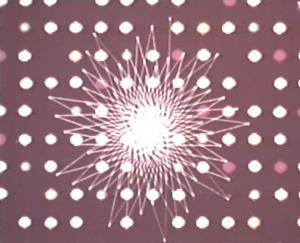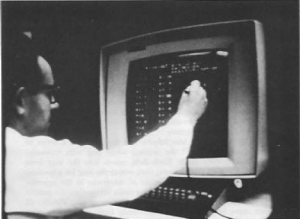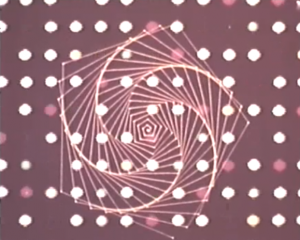John Whitney Sr’s first encounter with Dr Jack Citron, a physicist and researcher at IBM Los Angeles, in 1965, led to Whitney’s historic fellowship with the computer corporation between 1966-9. For Whitney, the IBM research grant was the ‘major change’ in his creative life: not only did it include ‘a modest annual income’, but it also gave him access to the latest, most advanced generation of mainframe computers – the IBM System/360 – with which to pursue his realisation of an integrated audio-visual motion graphics.[i] The computer architecture of the System/360 was innovative on its release in 1964: it was designed to be tailored to different kinds and scales of use, allowing customers to add to or ‘upgrade’ whilst preserving integration of components and programs through the same operating system, OS/360. IBM offered a range of different processors, giving unprecedented increases in speed courtesy of its own ‘microminiaturised’ Solid Logic Technology; storage capacity was claimed to be ‘virtually unlimited’ (from a few kilobytes on the model 20 to several megabytes in the later model 95 used by NASA for Apollo 11); and all components had built-in remote operations capability via a range of peripheral devices and interfaces – including the 2250 Display Unit featured in the IBM promotional film, Frontiers in Computer Graphics (1967).[ii]
Beneath the swinging background music, plain corporate title and dot pattern overlay, we catch an all-too brief glimpse of a series of advancing, flickering geometric forms:

‘Frontiers in Computer Graphics’ ,1967
These forms do not reappear in the course of the film and they are not credited to any of the ‘users’ featured, who collectively represent ‘typical problem solvers’ (structural analysts, electrical engineers, systems programmers, social scientists). This choice of examples evidently reflected IBM’s express intention to market the System/360 (and peripherals like the 2250) as an adaptable, multi-programmable system that could work across all contemporary fields of computing – commercial enterprises, scientific research, and government. It would appear that there is no room for ‘art’ here. The IBM 2250 was one of the first commercially available computer graphics display devices, with a monochrome cathode ray tube monitor, attached alphanumeric keyboard, fibre-optic light pen, and programmable keypad (as shown in Frontiers…). It was intended to fulfil two functions: to handle ‘the graphic information associated with scientific and engineering design applications’; and to provide ‘faster and more effective retrieval and graphic expression of management and business operating data.’[iii] (IBM 1971: 5) So when the documentary voiceover claims that the 2250 ‘represents the state of the art in graphic data processing’, it is clear that the application of ‘graphics’ lies in data processing rather than in ‘art’, least of all an art of graphics in motion…
Yet the flickering images at the beginning of the film bear a strong family resemblance to the first films made at the same time – and I would wager, on the same System/360 at UCLA – by Whitney under his IBM research grant: Homage to Rameau (1967), Permutations (1968) and particularly Osaka 1-2-3 (also 1968). Their geometric functions are also reminiscent of the Lissajous figures he had produced a decade earlier for Saul Bass’ title sequence to Vertigo (Hitchcock, 1958).[iv] Whitney had made the Vertigo figures using the innovative ‘animation mechanism’ that he had built out of a discarded M5 gun director, which he would later describe as ‘really a mechanical model of the modern digital computer graphic systems’.[v] Indeed, it was after seeing examples of the films John and his brother James had made with these mechanisms that Jack Citron wrote two programs for Whitney to operate the 2250, using a modified set of variables and statements he had developed for the FORTAN language, called GRAF (Graphic Additions to FORTRAN).[vi] According to a 1966 survey of ‘Computer Programs Designed to Solve Humanistic Problems’, Citron wrote at least two programs using GRAF, which appear to be the ones Whitney used during his IBM Fellowship: a ‘Polar Geometric Display Program’, which would ‘display geometrically a mathematical equation either to study the equation itself or to produce artistic designs’; and an ‘animated Design Program’ which allowed the computer to be used to ‘create motion pictures of functions of time suitable for an animated art form’.[vii] The former was a polar coordinate design program, which required a further ‘learning program’ in order for Whitney (a self-confessed mathematics drop-out, albeit one with a gift for engineering!) to acquire the requisite programming skills; and the latter allowed the 2250 to control an external camera to film image sequences programmed by punched cards.
What the 2250 and Citron’s GRAF programs offered Whitney is recognisable as a rudimentary graphic user interface (GUI), allowing him to select values for any of the sixty parameters of the ‘Polar Geometric Display Program’.

Dr Jack Citron (still from “Experiments in Motion Graphics”, John Whitney 1968)
In their joint presentation to the Fall Joint Computing Conference in November 1968,[viii] Citron and Whitney state that the user of these programs as ‘can be expected to have the sense and sensitivity of an artist in manipulating given geometric figures’, which strongly indicates that Whitney himself is the model ‘artist’. As such, the model of animation process remains modeled on the working practices that he had already developed:
With a working knowledge of this language [i.e. GRAF], an artist can compose choreographic movements of simple or complex visual patterns and exercise control over such elements in ways never before possible. With additional darkroom techniques, he can make still further use of technological developments to add color and even sound as well as indulge in the purely human process of editing.[ix] (1968: 1305)
This account of the production process developed by Whitney attests to the shortcomings of the 2250 for the creation of a new art of digital motion graphics – or rather, it illustrates the lack of a clear break between the analog and digital in any such art. This is apparent from the three stages of animated image production outlined by Citron and Whitney:
- the 2250 is used to programme the parameters of the image sequences (‘static program’ mode);
- the punched data cards are used to coordinate the display of the image sequences on the 2250 with the operation of a modified 35mm motion picture camera;
- the 35mm negative is printed on high contrast stock allowing for the sequences to be processed and coloured using Whitney’s hand-made optical printer.
Such a process is clearly dependent upon the analog process of optical printing, but the use of punched cards as data storage is no more ‘digital’ – and no more so than the spinning disc of an optical hard drive, of course.[x] If Permutations is one of the outcomes of such ‘computer assisted movie production’, then we might ask to what extent it is accurate to describe it as ‘digital animation’ when the transfer between digital and analog processes are crucial to its production. What Whitney encountered, as Gene Youngblood pointed out at the time, was the ‘curious nature of the technological revolution… that, with each new step forward, so much new territory is exposed that we seem to be moving backwards.’[xi] What Whitney had once described as his ‘delayed double-take’ – that glance from analog mechanisms to digital systems – thus remains instructive for our present moment, in which the exponential curve of technological development is so often summarized by an unquestioned turn to ‘the digital’. For if the Whitney-Citron collaboration is one of the crucial filaments out of which the history of ‘computer animation’ is braided,[xii] it raises some interesting questions about the technical, material and aesthetic genealogies of so-called ‘new media’ – and in particular the ongoing ‘legacies’ of analog systems and mechanisms within the ‘digital’.
[i] The System/360 used by Whitney and Citron was a model 75 (the highest spec system of the 360 range in 1965) and was based at the Health Sciences Computing Facility of the Medical School, UCLA. Quotation from Maureen Furniss’ interview with Whitney, published in Film Forum (1992).
[ii] IBM, Frontiers in Computer Graphics, promotional film (Pacific Productions, 1967). Available online at YouTube – http://youtu.be/6bI164G26dg
[iii] IBM System/360 Component Description: IBM 2250 Display Unit Model 1. 4th edition, May 1971. Available online at: http://www.bitsavers.org/pdf/ibm/2250/GA27-2701-3_2250mod1Descr.pdf
[iv] Although there is no evidence that Whitney was involved in the production of these images, their presence in this IBM film, at this time, and in this place, is suggestive of continuing feedback processes between Whitney’s experiments in motion graphics and the fields of art, entertainment, science and business.
[v] John Whitney, ‘Animation Mechanisms’ [1971], Digital Harmony (Byte/McGraw Hill, 1980), p.171. See also Maureen Furniss’ interview with Whitney, published in Film Forum (1992): ‘Moving in that direction, it finally became clear that I was actually struggling to invent a computer.’
[vi] John would later refer to James’ film, Lapis (1966), as ‘the best film that was made with those technologies’ (Whitney, in Furniss 1992)
[vii] ‘Computer Programs Designed to Solve Humanistic Problems’, Computers and the Humanities, 1:2 (Nov., 1966), pp. 39-55.
[viii] This was the same JCC at which Doug Engelbart introduced, among many other things, ‘a hand-held X-Y transducer usable on any flat surface’ – i.e. what he had already dubbed the computer ‘mouse’.
[ix] Citron, Jack & John Whitney, ‘CAMP – computer assisted movie production,’ Proceedings of the Fall Joint Computer Conference 1968. Afips, pp.1299-1305; p.1305. Available online at:
http://www.computer.org/csdl/proceedings/afips/1968/5072/00/index.html
[x] I take this point from Matthew Kirschenbaum’s proposal for a ‘machine reading’ of hard drives in his excellent book, Mechanisms: New Media and the Forensic Imagination (MIT Press, 2006).
[xi] Gene Youngblood, Expanded Cinema (Studio Vista, 1970), p.191.
[xii] Tom Sito rightly acknowledges the historical precedence of Ivan Sutherland’s Sketchpad (1962), and the parallel collaboration at Bell Labs between Stan Vanderbeek and Ken Knowlton; see Moving Innovation: A History of Computer Animation (MIT Press, 2013).
Richard Stamp teaches film and literature at Bath Span University. His research and teaching combine interests in moving image cultures and technologies (especially animation)with philosophy and political theory. He is the editor (with Paul Bowman) of “Jacqu Rancière: Critical Dissensus” (Continuum, 2011), “Parallax 52” (‘Jacques Rancière: In Disagreement’, 2009), and “The Truth of Žižek” (Continuum, 2007). He is currently working on two animation projects: a critical-historical exploration of ‘animation theory’; and a study of the work of John Whitney Sr.



This is incredibly fascinating. I wish to further understand John Whitney’s impact on contemporary visual music. Do you have any recommendations of readings or research I could explore?
I was at the IBM LASC at that time and know Jack and his wife Jobie. Is there anyway I can contact them — aiisreal@post.tau.ac.il?
Thanks
Alfred Inselberg
Tel Aviv University
Is Citron still alive? I believe he wrote ‘Cybernetic Music’ (Tab Books, 1985 – see http://amzn.to/1ccJ96o for a review) under the pseudonym ‘Jaxitron.’ The book describes a system for computer generated music using the APL programming language, based on ideas developed by Joseph Schillinger (http://en.wikipedia.org/wiki/Joseph_Schillinger). It would make sense if Jaxitron is IBMer Jack Citron, given that APL was a popular programming language within the company at that time.
This was an extremely fascinating read Richard. It raises some very pertinent and timely questions over the historiography of “new media” and the tensions between analogue and digital processes. I am very keen to see where your research goes.
Thanks Aimee! I think that there are some very interesting questions emerge as soon as you start to pay close attention to that analog-digital relation – this is what Matthew Kirschenbaum is doing in his reading of the ‘hard drive’ in *Mechanisms*, which he refers to as a kind of ‘machine reading’…